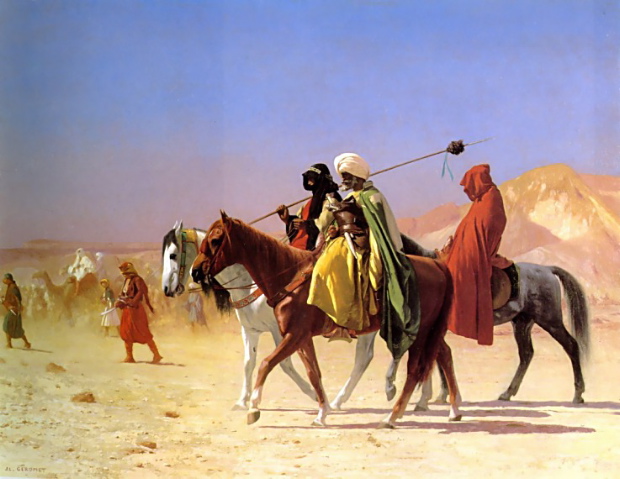
One of the artist’s popular desert scenes. It’s hard to imagine that David Lean, or his cinematographer Freddie Young, didn’t study these when preparing to shoot Lawrence Of Arabia, which is like a series of Gérômes come to life.


One of the artist’s popular desert scenes. It’s hard to imagine that David Lean, or his cinematographer Freddie Young, didn’t study these when preparing to shoot Lawrence Of Arabia, which is like a series of Gérômes come to life.
![]()
Alfred Hitchcock was raised a Catholic and educated by
the Jesuits. The influence of his Catholic upbringing is evident in
his films, sometimes in surprising ways.
On a purely psychological level, Hitchcock was
attracted to stories in which someone is judged unfairly,
mistaken for someone else and asked to pay for that other person’s
sins. This is a common enough response to the harsh and demanding educational
system of the Jesuits — a sense of living under perpetual (and
seemingly unjust) accusation. In many Hitchcock movies the unfairly
accused protagonist redeems himself by heroic actions — which in
theological terms might be related to the doctrine of justification by
works, the idea that a man can, with a little help from God, save
himself by his own actions.
But there’s deeper and more complex theology at work in certain of
Hitchcock’s films — most notably in I Confess and The Wrong Man.
Interestingly enough, these are two of the director’s most naturalistic
films, shot in great part on location and in black and white. It’s odd
that when he wanted to delve most deeply into religious themes he
should have chosen to present them in a quasi-documentary form.
In I Confess a priest, played by Montgomery Clift, is unjustly accused of a
murder. The real killer has confessed to him, but he can’t, as a
matter of religious conviction, tell anybody about it. In this film,
the protagonist does not redeem himself except by passive sacrifice.
His heroism is simply to accept his fate humbly, stick to his faith.
![]()
His convictions here are church-related — he must
sacrifice himself to the principle of the sanctity of the confessional,
to ecclesiastical procedure. He’s saved from paying the ultimate
penalty by the witness of another character, who sacrifices herself to
reveal his innocence. Presumably his own sacrificial posture has
inspired her to this act.
So far we are well within the Catholic tradition, which sees the church, personified in the figure of the priest, as a divine agent in the world — adherence to its doctrine and ritual leads to salvation.
But something very different is going on in The Wrong Man. Here an innocent man, played by Henry Fonda, is accused of a crime and his whole life is
shattered. He’s a religious man, and carries his rosary beads with him
through his ordeal — but it doesn’t seem to help. The wheels of
justice, the oppression of the legal system, operating quite reasonably
on the face of it, crush him like an insect.
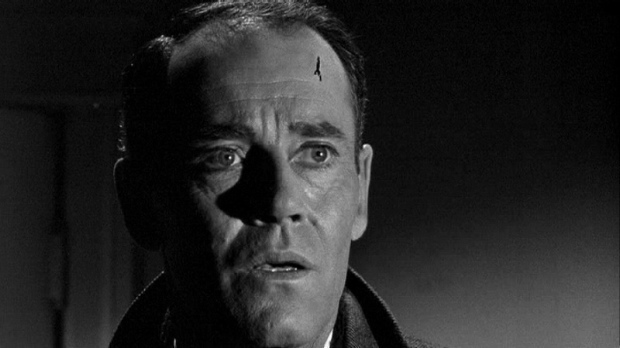
Finally his mother asks him to pray — and he does,
not with the rosary beads, not in a church, but directly to an image of
Jesus. Instantly, the real criminal appears and is caught — the
accused man is redeemed.
This is a long way from Catholic theology in that the
church plays no mediating role. It’s just between “the wrong man” and
Jesus. He’s saved by no action of his own, not even by the humble
acceptance of his fate. He’s saved by a simple cry for help.
We’re now, oddly enough, in Protestant theological territory, closer
to the doctrine of justification by faith, in which neither the church
nor the suffering man play any role whatsoever in the man’s salvation,
which is a gift of Grace from God, pure and simple.
It’s clear that in these two films Hitchcock was not just expressing resentment over the terrors and the residual guilt inculcated by a Catholic
education. He was articulating complex themes in Christian
thought, trying to dramatize them in an entertaining way but also to
situate them in the real world, in a plausible evocation of modern-day
Quebec, where I Confess is set, and New York, where The Wrong Man
is set.
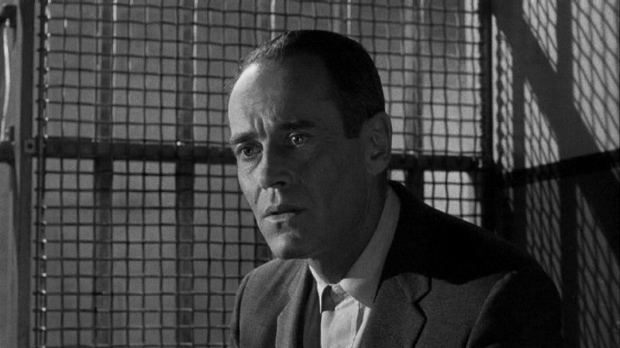
“Film is not a slice of life,” Hitchcock famously
said, “it’s a slice of cake”. But there’s very little cake on display
in either of these films — and in the mean streets of The Wrong Man,
in the suffocating rooms and cells and hallways of police stations and
prisons and courthouses, there is only wormwood and gall.
The two films stand out as great and profound works of
Christian art, explicit meditations on Christian theology in a century
(and an industry) not noted for such concerns. Like all good parables
they can be enjoyed simply as stories, but Hitchcock makes it very
clear (see the image from I Confess at the beginning of this post) that he had heaven on his mind when he made them, that he was
asking deep questions about the nature and the mechanism of salvation.
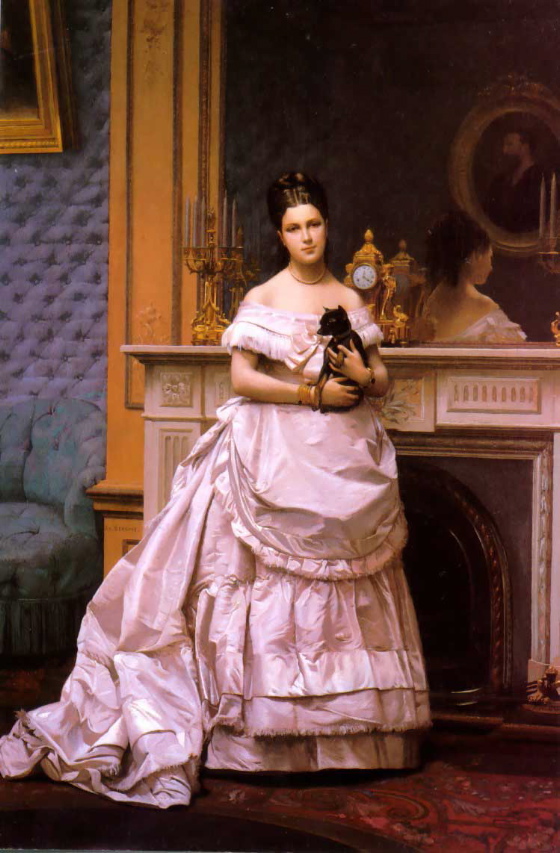
In the mythology of modern art history the realist painters of the
Victorian era fought a losing battle with the photograph and eventually
capitulated to the dominant aesthetic of 20th-Century art, with its
irresistible (and progressive) trend towards a greater and greater
abstraction, abandoning both pictorial realism and almost all narrative
ambitions.
In fact, however, realist painters of the Victoria era conducted an
exciting and productive dialogue with the photograph, incorporating its
apparent authority but also, at the same time, extending its range of
representation beyond the technical limits of the 19th-Century camera.
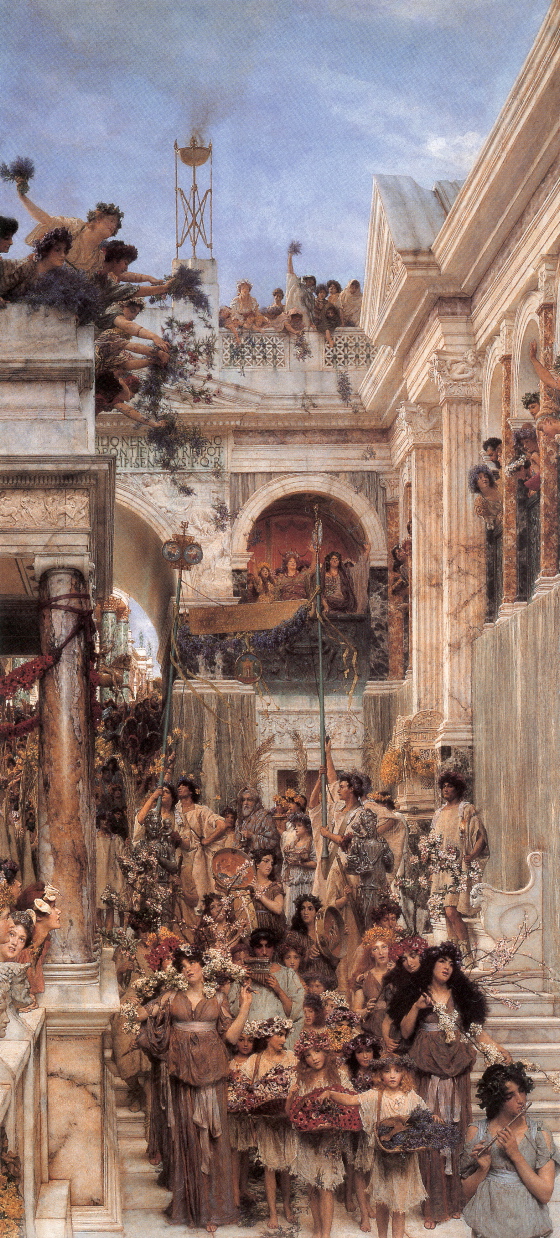
Academic art surrendered not to the abstractions of the 20th-Century
painter but to the great artists of the early cinema, who assumed the
narrative and representational ambitions of academic art in a medium
which had, at least as far a popular taste went, better resources for
realizing those ambitions. You could almost say that the academic art
of the 19th-Century was born again, gloriously, in a new medium, which
it deeply influenced.
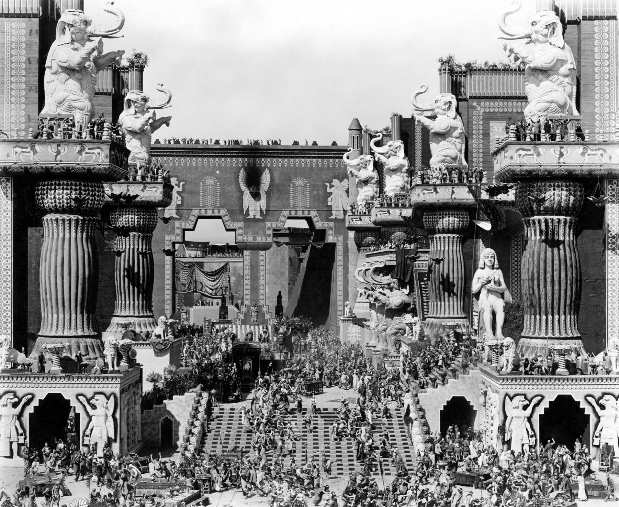
Academic art taught movies how to orchestrate photo-realistic elements
into theatrical forms, using lighting, framing and the placement of
figures in space to create a hyper-realistic illusion that had the
coherence of actual visual experience even when departing from it in
fabulous ways. Because film could capture motion, and thus emphasize
the plasticity of space far more expressively than the easel-painter,
it rendered the academic easel-painter’s art passé. It was motion and
the greater illusion of spatial depth it allowed which lost academic
art its popular following.
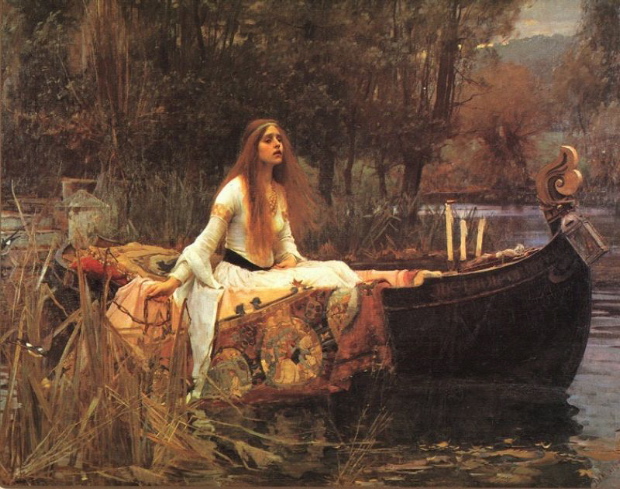
But much more than that was lost, especially in the realm of color. Up
until very recent times, color film stocks couldn’t begin to reproduce
the range of lighting conditions which the Victorian realist painters
gloried in. By marrying, through draftsmanship, an almost photographic
realism with an über-photographic sensitivity to color and light, the
Victorian painters anticipated cinematic effects which remain difficult
to achieve even today.
The attempt to devalue the work of Victorian painters, seeing them as
obstinate blocks to the steady progress of art, was a strategic ploy on
the part of 20th-Century modernist painters and their apologists in the
academy and the marketplace. Engaged in a project which would divorce
art from popular taste and arrive at an aesthetic dead end before the
end of the 20th century, they posited a straw man in the person of the
reactionary academic practitioner which lent their own schools an
undeserved glamor and prestige — even as the academic practitioner was
informing and inspiring the great new popular art form of the movies.
But the intellectual disgrace of the Victorian painters also helped
impoverish cinema, because, after the first glorious blossoming of the
art in the silent era, filmmakers forgot academic painting. To get
back in touch with its lessons, they had to get back in touch with the
masters of the silent era, like Griffith, Vidor, Murnau and Ford, for
whom Victorian academic painting was a living form and a direct
inspiration of their techniques. The filmmakers who followed them had
to engage Victorian academic art at one remove, and thus lost touch
with the very forms which had inspired and instructed the original
pioneers of cinema.
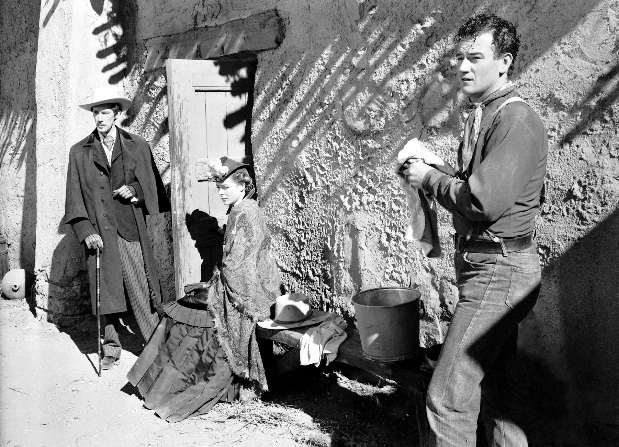
The propaganda of the modernist painters, understandable from their
point of view, resulted in a great loss to the visual culture of the
20th-Century. It couldn’t obliterate the glories of Victorian academic
painting, which survived, transformed, in movies and in popular
illustration (through the work of artists like N. C. Wyeth and Norman
Rockwell.) But it distorted the intellectual appreciation of a visual
tradition which might have been of great use to artists, film artists
especially, if they hadn’t been shamed into despising it on principle.
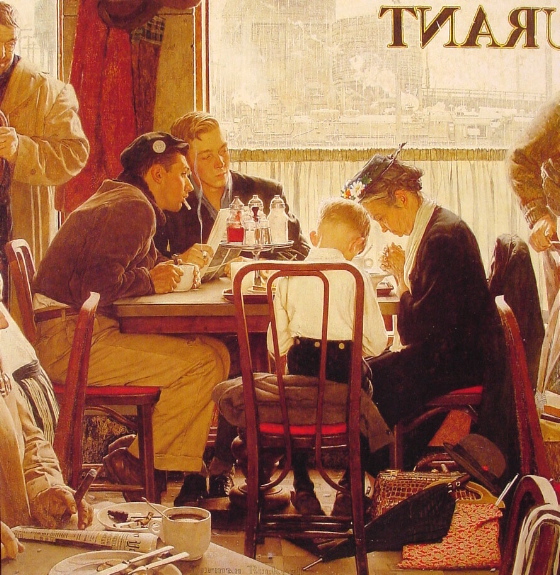
I would argue that a new appreciation of Victorian realist painting has
the power to recharge the art of cinema in our time — quite apart from
the pleasures to be gained by directly encountering a vital and
ravishing visual tradition.
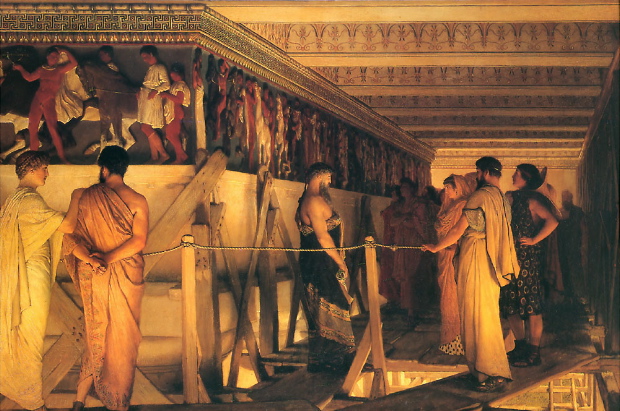
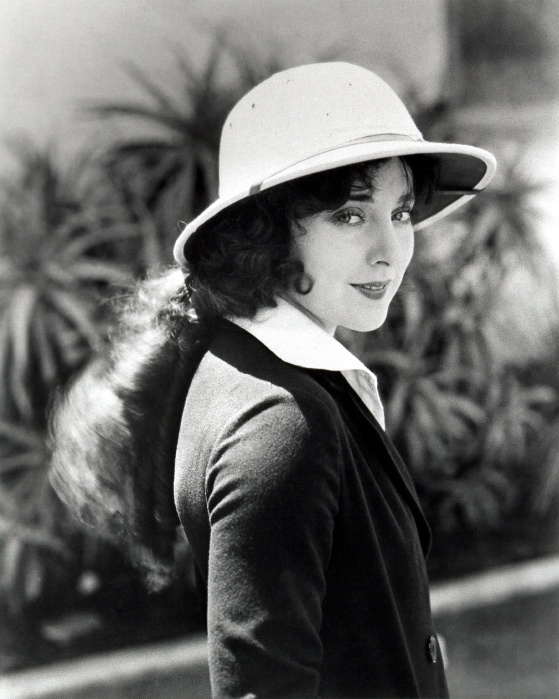
One of the most delightful sites on the Web is Dr. Macro's High-Quality Movie Scans.
Wandering through its galleries of movie stills, star portraits and
promotional graphics is a ravishing experience. Check it out.
[Above is the lovely and always vexing Jobyna Ralston, who co-starred
with Harold Lloyd in many of his best silent films. Below, a seminal
image from The Black Cat.]
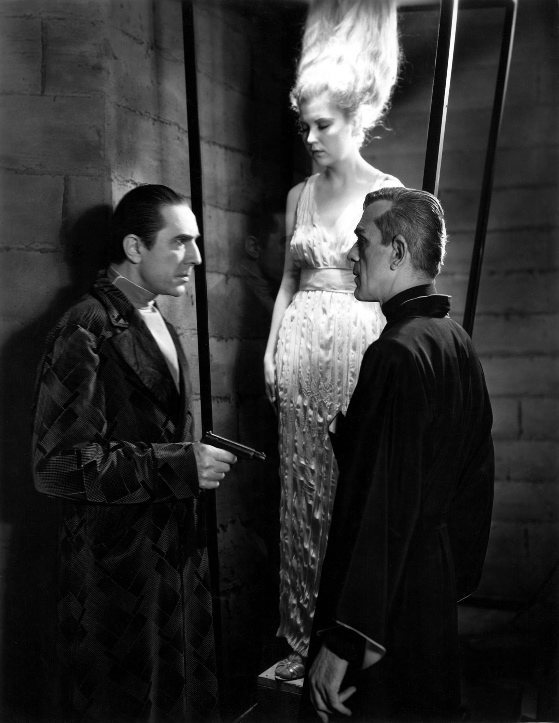
Frank Tashlin was the nut-case genius who unleashed
the nut-case genius of Jerry Lewis as a filmmaker. Before Lewis became
a director, Tashlin directed him in some important movies that helped
set the tone and strategy for Lewis' later work.
Tashlin basically showed Lewis that if in a film you
deconstructed the process of making movies and let the audience in on
the deconstruction in a lighthearted, complicitous way, you could
vastly expand the range of comic eccentricity possible in a mainstream
film. As long as the audience knew you were violating convention
deliberately and “just for laffs” it would then allow you to do and say
almost anything.
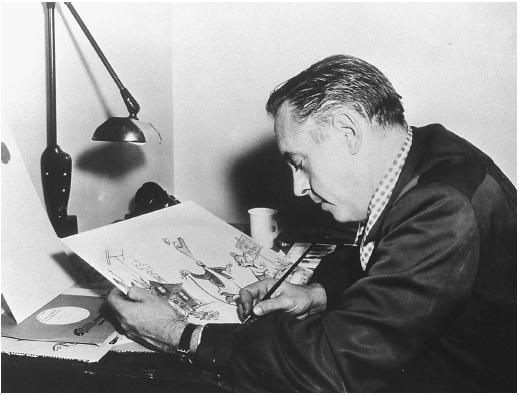
Tashlin started out in animation, so he had a good
idea of how much surrealism and aesthetic self-reflexiveness a
mainstream audience would accept. It was his genius to show how this
receptivity could be appealed to in live-action comedy.
The Girl Can't Help It, Tashlin's masterpiece,
starts out in black and white and in Academy ratio. Tom Ewell, the
male star of the film, steps forward towards the camera and announces
directly to the audience that the film they're about to see is in
Cinemascope. He waves his hands and the sides of the image expand to a
Cinemascope ratio. He also announces that the film will be in color —
more prestidigitation and the image becomes saturated with color.
“Sometimes,” he confides to the audience, “you wonder who's minding the
shop.”
Instantly Tashlin establishes a bond with the audience
based on the suggestion that the powers that be in Hollywood would give their customers
less than they wanted if they could get away with it — but Ewell, acting
on the audience's behalf, won't let the industry get away with it. The
implications of this are profound. Hollywood is the establishment,
part of the cultural compact of the nation. Once you're seduced into
suspecting Hollywood, you're ready to suspect everything.
But Tashlin doesn't leave it at that. As Ewell
chatters on, telling us that this movie is going to be about rock and
roll, Tashlin tracks in on a jukebox playing the title song, sung by
the highly suspect cultural icon Little Richard, and the song drowns
out the end of Ewell's monologue. Don't even trust the star, Tashlin
seems to be saying — don't even trust me.
I think it's probably a mistake to parse this film, and
Tashlin's work in general, looking for a programmatic critique of
movies or of American culture. Tashlin, like Nietzsche, is offering a
perspective from which a critique is possible, but he leaves the
conclusions to the viewer. Tashlin was interested in creating a
transgressive frame of mind, a frame of mind in which anything and
everything could be questioned — he wasn't interested in formulating
answers to the questions themselves. He liked, I think, the giddiness
of abandoning, of shattering received forms, the license it gave him to
free-associate — and that's what he does in this film.
The center of The Girl Can't Help It is the
iconic, cartoon-like image of Jayne Mansfield. Somehow Tashlin sensed
that the psychic chaos that could be induced by her sheer carnality was
somehow connected to the energy of rock and roll — that there was a
cultural matrix that generated both. There are times in the film when
he seems to be mocking this matrix, times when he seems to be
celebrating it. In fact he was just observing it in wonder — and
asking the audience to wonder about it, too.
There's a famous scene in which Mansfield bursts into
Ewell's apartment carrying two bottles of milk she's picked up from his
doorstep on her way in. She holds them up to her breasts like
extensions of those already preposterous attributes. On one level it's
a dirty joke. On another level it's a symbol of Mansfield's
innocence. On a deeper level it can be read as an acute analysis of
the male breast-fixation in post-WWII America — not a sexual thing at
all, at bottom, but an infantile regression, a lust for the alma
mater.
There are any number of such suggestive images in The Girl Can't Help It.
The complex ways African-Americans are presented in the film deserve an
essay of their own. One image can serve as an example — the
gorgeous African-American singer Abby Lincoln, dressed in a spectacular
sparkling evening gown, sexy and elegant, is shown on a cabaret stage lit in lurid colors . . .
singing a Gospel song. This is beyond satire, beyond surrealism
— it's an image as strange as American culture itself.
The lines of thought are never clear in Tashlin's best
work — and that's its value. In the
social currents he observed colliding and redirecting each other, echoed in the wildly clashing colors of his cinematography, Tashlin uncovered
perplexing contradictions in America culture and threw them in our
faces like so many custard pies. All we can do in response is wipe the
custard out of our eyes and wait for the next one.
His work in the Fifties was excellent spiritual
preparation for the Sixties — a cultural slapstick routine that still
challenges complacency in any form.
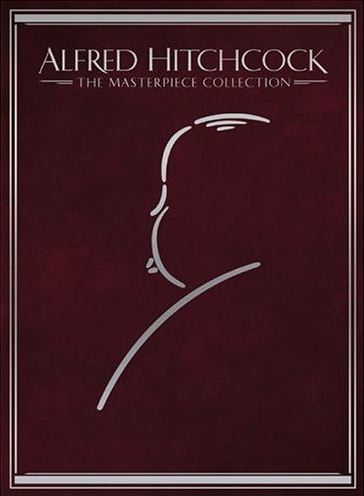
Alfred Hitchcock: The Masterpiece Collection,
a 15-disc DVD box set, might be the best bargain in the entire history
of entertainment. It includes 14 films plus a bonus disc of
extras, and can be had from Amazon for $84.99, possibly less from other sources
— about $5.70 per disc or about $6 per film. Four of these films
are indeed masterpieces of world cinema, two are minor masterpieces,
two are interesting misfires, and the rest are just superior
entertainment with bravura passages of pure, breathtaking cinema.
Each of the films has, among other extras, a short documentary about the making of it,
including some fascinating interviews with Hitchcock collaborators, and
the bonus disc has longer documentaries about the making of Psycho and The Birds. The Vertigo
disc, which offers the best DVD transfer of the film currently
available, has an excellent commentary by one of the film's producers
and by the two men who did the comprehensive modern-day restoration of
Hitchcock's masterpiece.
If you invest in this set, and an equally wondrous companion set called Alfred Hitchcock: The Signature Collection,
which has another 9 of Hitchcock's best movies for about $53, you will
never spend another restless rainy night at home in front of the
television. You will have an endless supply of enchantment. Just add popcorn.
You can check out the contents of the sets and buy them here:
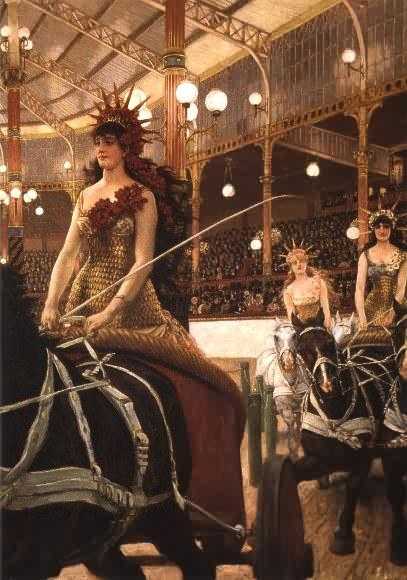
Ces Dames de Chars.
Notice how the lead horse gallops into an imaginary space in front of
the canvas, while the eye is simultaneously drawn in the opposite
direction, through a series of distinct interior spaces within the image — the bright covered arena, the darkened audience galleries — that open up
behind the lady charioteers.
To read more about Tissot go here.
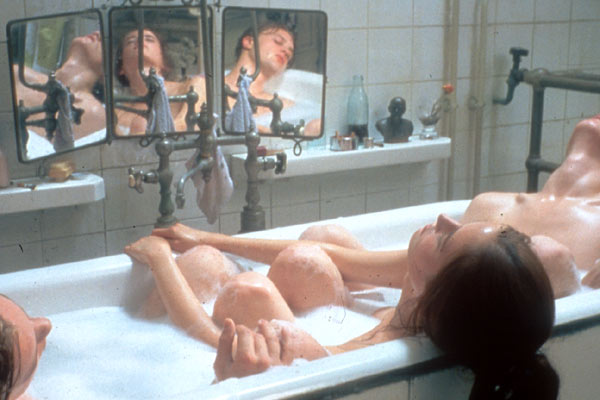
Bernardo Bertolucci is one of the great masters of cinema, but he has rarely found film stories and/or scripts equal to his genius. There are passages in almost all of his films as extraordinary as any in the history of movies, but he has made more bad movies than almost any other important director. The Dreamers is one the most misguided of his misses — a stilted, inauthentic evocation of the Sixties stifled by the nostalgia of old men for their youth (the movie is based on a novel by a guy who, like Bertolucci, was a young man in the Sixties.) Indeed, nostalgia is too strong a word for it, since nostalgia implies
at least a trace of yearning, of passion — and this movie is basically a smug intellectual appreciation of the Sixties, and of youth, disguised as a drama.
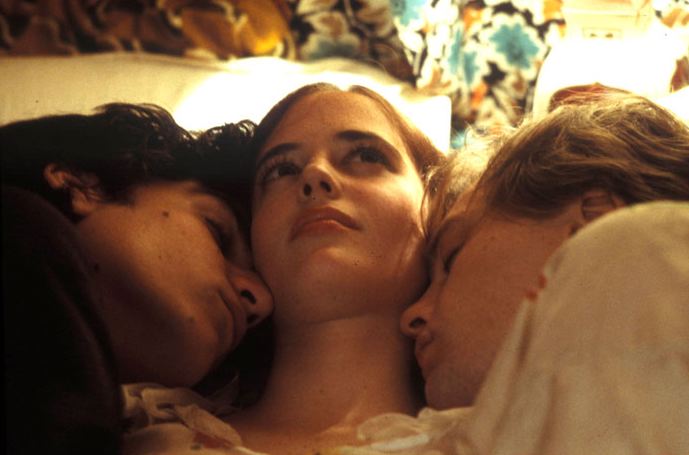
There’s lots of sex and nudity — almost no real sensuality or erotic joy. And kids in the Sixties never talked the way the kids talk in this movie — not even the ones who were intellectual film buffs. The Sixties rock songs on the soundtrack and the intercut clips from films of the French New Wave, especially those by Godard, still seem fresh and alive — almost mocking the tired vision of the screenwriter and director. There are great visual passages in the film, and Bertolucci’s director’s commentary is brilliant — indeed, the film
is best seen as a pale and unconvincing illustration of that commentary.
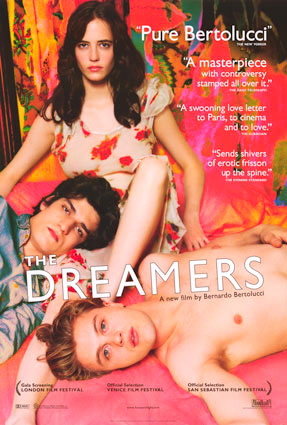
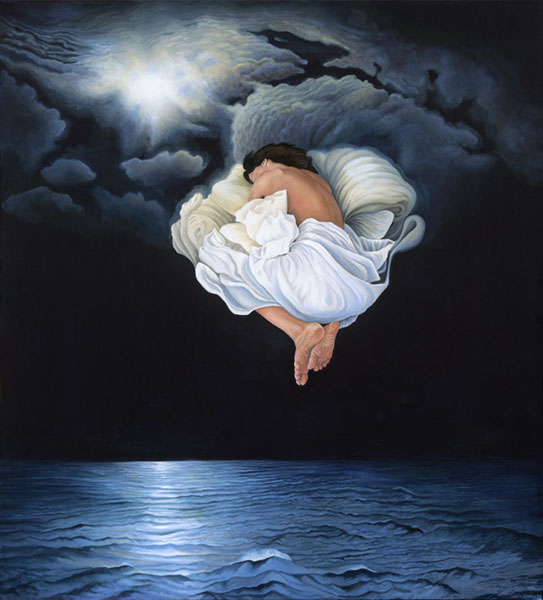
Here are some of the astonishing images of Houston-based artist Lynn Randolph. At times Randolph’s work harks back to the paintings of Frida Kahlo in its contrasts of bold, warm colors and in the placid, self-possessed sensuality of its female subjects. But it also echoes at times the hard lines and the precisely delineated dream landscapes of the painters of the Northern Renaissance. Certain paintings, like the nude on the bed below, entitled The Wetlands Of Desire, suggest the calm derangement of Magritte.
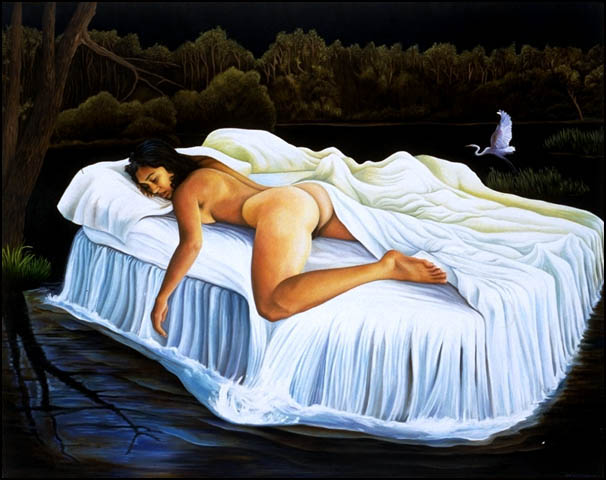
Randolph’s art exists in lively conversation with the past — not trying to be new but also transcending pastiche, as her disciplined dialogue with the vanished masters ends up revealing her eccentric sensibility more clearly than aggressive innovation might have.
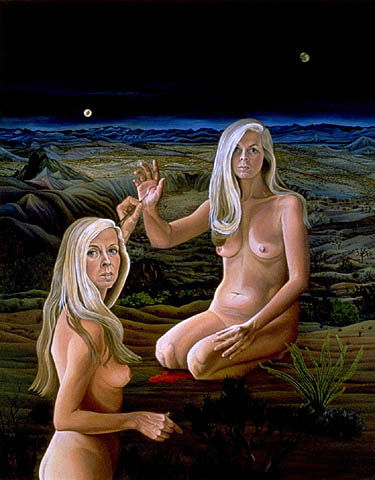
The painting directly above, which must certainly be a self-portrait, offers an intimate connection with the viewer, as the artist’s eyes seem to engage ours in a moment of unguarded confrontation, just as some of Rembrandt’s self-portraits do — yet the painted image within the painted image, raising its hand as though to welcome the sensual touch of the brush, speaks of another kind of intimacy, between the artist and her work, her vision, which we cannot quite share. It has an odd auto-erotic charm.
Recently Randolph has done a series of magical dream-seacapes, like the paintings at the beginning and end of this post, which are really breathtaking.
For more info on Randolph and to see more of her paintings go here:
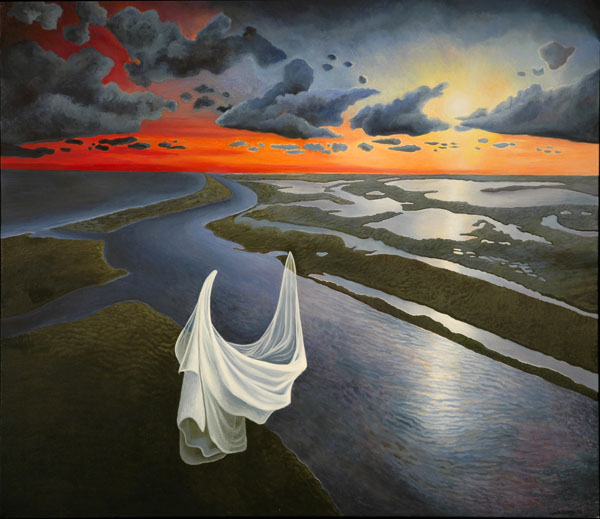
Alfred Hitchcock’s Shadow Of A Doubt, from 1942, is a kind of proto-film-noir. It shares the dark view of human nature and the deeply skeptical vision of “respectable” society that would inform the post-WWII film noir. WWII was just getting under way for America when the film was made, but much of the rest of the world had already been at war for three years by then, and clearly the global conflagration was beginning to create a deep anxiety in the psyches of sensitive, thoughtful artists like Hitchcock and Thornton Wilder, who co-wrote the screenplay.
At the beginning of the century America had participated in a “war to end all wars” and now the continents were aflame again. There seemed to be some intrinsic, irrepressible evil in the nature of human beings, or in the organization of their societies, which led to wholesale destruction at regular intervals, despite the best efforts of mankind’s intellect and collective goodwill.
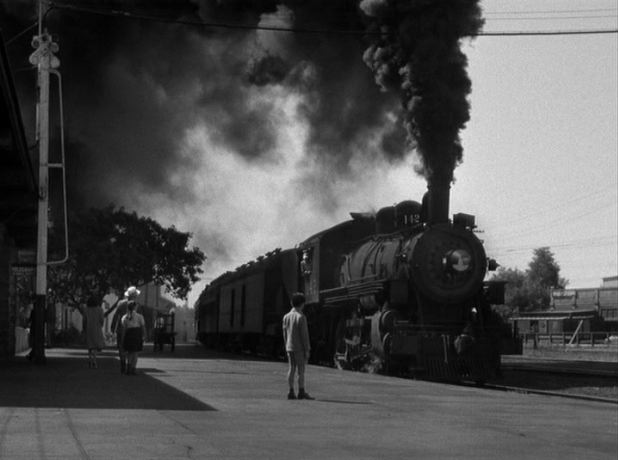
The fragility of human institutions, especially the family, was acutely sensed. Shadow Of A Doubt was pre-noir in that it didn’t concentrate on the world’s corruption or on the impotence of manhood, personified in the devouring femme fatale, but rather on the human being’s inward capacity for evil, which seemed to erupt without reason or warning. “The world needs watching,” says the young hero at the film’s end — meaning, mankind needs watching. There was still, in 1942, a faith in the idea that watching might do some good. At the core of the post-war film noir was a sense that such a faith was delusional.
The magnificent irony at the heart of Shadow Of A Doubt is that the threatened family is presented at the beginning of the film as a trap, a web of annoyance and boredom. The glamor of the unconventional, rootless, iconoclastic Uncle Charley is presented as a deliverance from the suffocating everyday reality of family and small-town life.
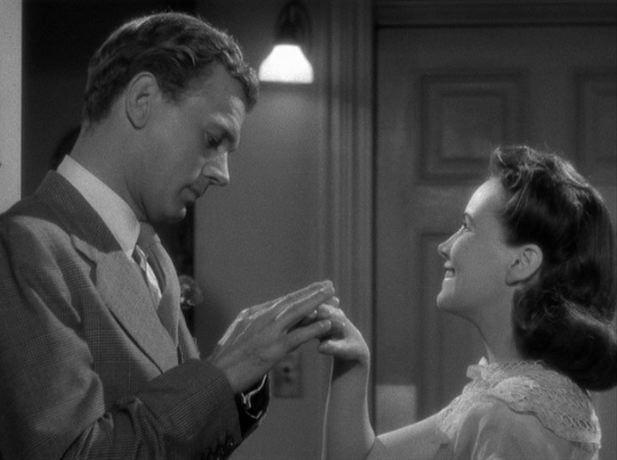
But as our suspicions of Uncle Charley grow, we begin to treasure the ordinary goodness of the family he seems to be rescuing from its rut. Only in the light of their fragility can we appreciate family and community for the treasures they are, the bulwarks they are against the world’s insidious darkness.
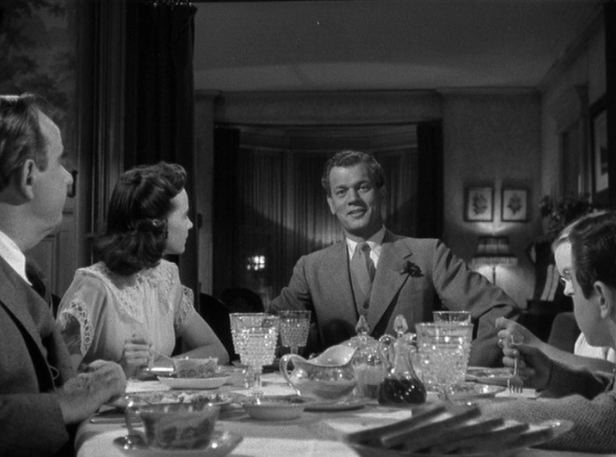
It’s easy to see how this related to the mood of the nation, and the world, when the film was made — but its resonance has if anything grown deeper as the post-war era has played out, with the family and community in deeper and deeper jeopardy, threatened now in “advanced” societies not by external violence but from within. Wilder and Hitchcock are still reminding us how truly naked and vulnerable we are in the face of the world’s horrors — still reminding us that those horrors originate in the human heart, and that our few defenses against them are both frail and inexpressibly sweet.
Shadow Of A Doubt was Hitchcock’s favorite film — he certainly never made a greater one.
City Girl, F. W. Murnau’s last Hollywood film, doesn’t have nearly the reputation
of Sunrise, his first one, but it is in some respects a greater work
and a more exciting one — if only because one can see in it Murnau’s
road to the future as a Hollywood director, if he’d lived and chosen to
remain one.
It has many themes in common with Sunrise, though here they are sometimes
inverted. A beleaguered city girl dreams of a more decent and hopeful
life in the country, meets a decent country guy who takes her off there
— and discovers the same oppression, in a different form, among the
wheatfields.
What the films have in common is a concern with good, simple people who fall
in love and whose love is tested by the meanness of the world around
them. In Sunrise the characters are iconic, almost symbolic of the
virtues they possess — they rise above stereotypes only through the
charm of the players. But the characterizations of City Girl are
naturalistic, particularized, sharply observed — greatly aided by
excellent dialogue in the intertitles.
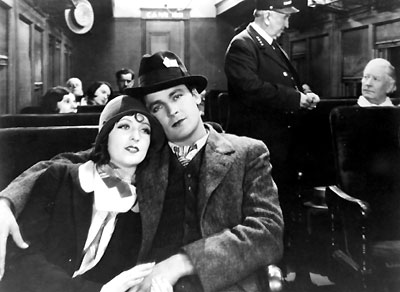
Charles Farrell and Mary Duncan are brilliant in their roles. Farrell has the
same combination of sweetness and virility that makes George O’Brien
such an appealing hero, and Duncan’s carefully calculated balance of
hardboiled city dame and innocent dreamer is masterful. She is the
heart of the film and her experience drives it. It’s an oddly feminist
vision — the meanness of the world on exhibit here is mainly reflected
in an abuse of and disrespect for women — and Duncan’s heroic
resistance to this is thrilling, and startling. We would not see this
kind of female response to male abuse on screen in Hollywood again
until the Sixties, when it appeared in a brittle, dogmatic form far
removed from the heartfelt indignation of City Girl.
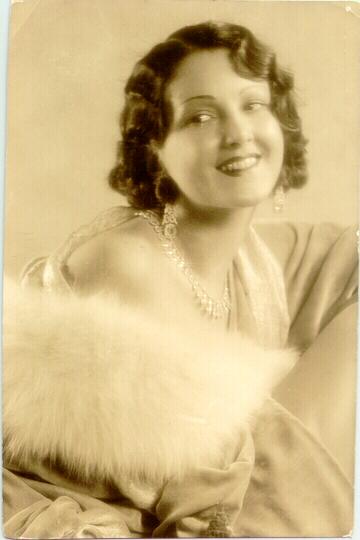
Along with the naturalism of the characterizations, more in line with
American style than the grave symbolism of Sunrise, is a less fevered
visual method — one that doesn’t announce its aesthetic ambitions
quite so loudly but that still often soars to heights of brilliance.
The long tracking shot through the wheatfield when Farrell and Duncan
first arrive at the farm, filled with hope and joy, is perhaps not as
complex technically as the moody track through the moonlit swamp in Sunrise, but it’s just as exhilarating as a piece of plastic invention and serves its dramatic moment with the same stunning efficiency and elan.
The shots of the wheat harvest with the mule-drawn machinery are equally
exhilarating, lyrical, powerful. They offer an image of timeless,
ennobling labor which contrasts profoundly with the individual
pettiness of the human characters who are operating the machines.
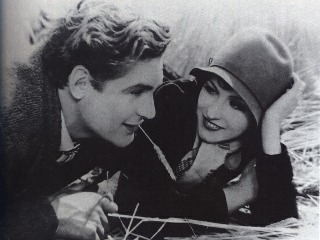
I think it’s fair to see City Girl as Murnau’s first experimental step
in creating a genuinely American style — one that might pass muster
among the conventional but canny minds who directed the studios, among
audiences of everyday moviegoers not especially enamored of the
European art-house mode . . . and yet one that could still incorporate his
unique plastic imagination and convey his deeply humane concerns.
It’s one of Murnau’s great films, one of the great silent films, one of the great films — its place in history, in the shadow of Sunrise, is wholly undeserved.
Norman Rockwell was not the least of the Victorian academic painters, even
though he lived in the 20th-Century. He perfected the
photo-authoritative aesthetic of the late Victorians and used it for
complex narrative purposes. The official Victorian academy was
swept away as a fountainhead of popular art by the invention of movies,
but Rockwell competed with movies directly and survived. Indeed,
he triumphed. His images seem like stills from imaginary
movies — movies more wonderful and moving and entertaining than even
Hollywood could turn out.
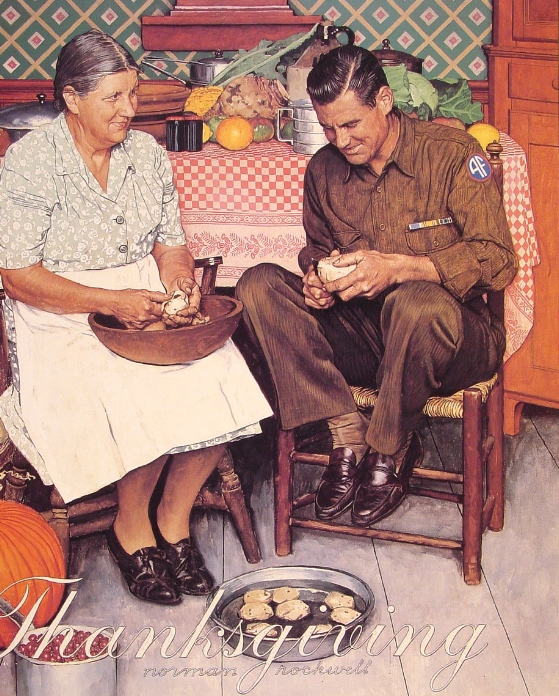
I can’t imagine that any filmmaker from Hollywood’s so-called golden age, the studio era, wasn’t influenced on some level by Rockwell’s art. Steven Spielberg, a
connoisseur and student of that golden age, has an original Rockwell
hanging behind the desk in his office.
Many modernist painters will admit to admiring Rockwell, but the
20th-Century art establishment in general marginalized and even stigmatized his work for the crime of being popular in the mainstream
culture — not just noticed and known but intensely loved — and
for embracing a tradition linked to the achievement of the discredited
Victorians.
Anyone with eyes can see what nonsense that was.
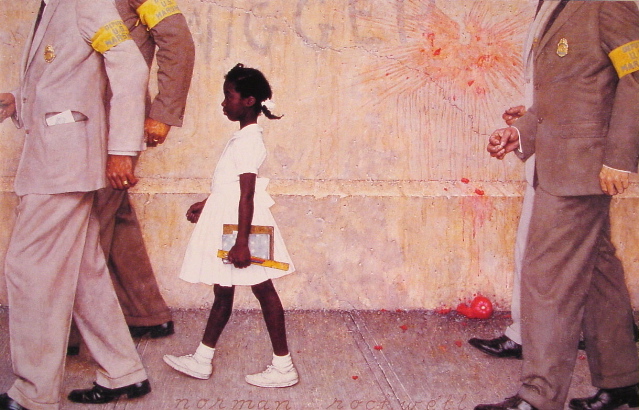
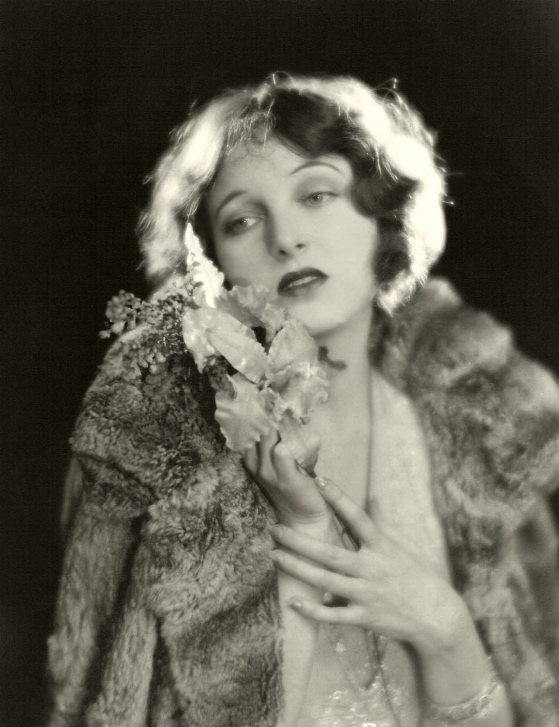
The Garden Of Eden is as charming and delightful a film as Hollywood
ever turned out in the silent era. It's also a most curious concoction
— a light Viennese-style romantic comedy directed with a kind of
gum-chewing sidewise humor that's distinctly American . . . sort of like
a Lubitsch comedy as it might have been imagined by Howard Hawks.
The film is radiant with visual invention and style — it makes its nod
to Lubitsch's visual wit but eschews his delicacy . . . the visual gags
here are more like carelessly tossed-off wisecracks.
The result is a perfect showcase for the marvelous Corinne Griffith,
appealingly casual and fresh but capable of deeper emotional
undercurrents. She was a real star. Her leading man in this
contemporary Cinderella fable is Charles Ray, who's generally charming
but threatens at every moment to become just a little too fey to hold
his own with his formidable co-star.
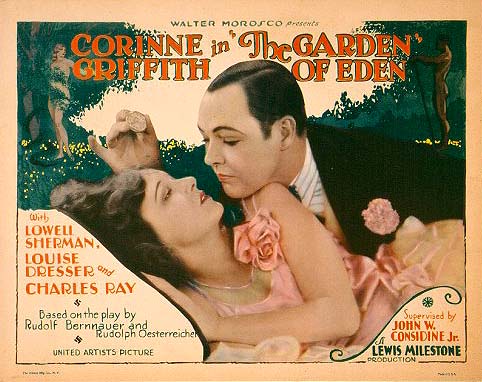
As Griffith's Cinderella prepares to marry her prince, she acknowledges
that almost everything she's wearing was a gift from her husband-to-be,
but adds that she provided her own underwear. When complications ensue
she removes the gifts defiantly and races through the wedding party in
her skivvies — and we're suddenly a very long way indeed from the
subtle sexuality of Lubitsch's world. Griffith's Cinderella has the
soul of a flapper, and we're relieved that her upper-class fiance has
the wisdom, finally, to appreciate her for who she is . . . and she is,
unmistakably, details of the narrative notwithstanding, an American girl, in her own underwear.
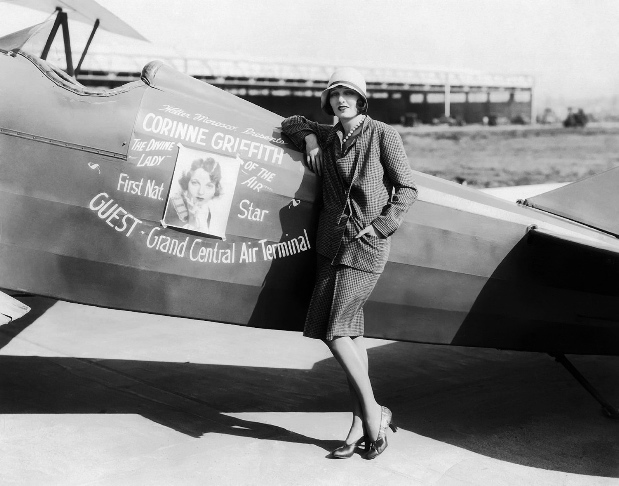
Vertigo, Alfred Hitchcock’s masterpiece from 1958, is about many things — that is, it can be analyzed from many different perspectives — but one of the most important things it’s about is the medium of movies itself.
Every work of art is on some level about the medium in which it’s created — its nominal subject, sometimes confused with its “content”, is often merely an excuse for a demonstration of the metaphysical resonance of a particular set of techniques. The process of art itself is a subject, a conveyor of meaning, which interacts with the nominal subject of a work in complex ways.
The technique of Jan Van Eyck’s Altarpiece Of Ghent testifies to a lifetime of study and mastery in the discipline of painting, a supreme commitment to the medium, which is inseparable from the religious devotion of the work — they become co-identical. By the same token, when Robert Rauschenberg wraps bits of an old tire around a tree stump and calls it sculpture, he is expressing a cynicism not just about art but about life, about all human endeavor.
The obvious text of Vertigo, the narrative element which can be rendered into words, clearly has parallels to filmmaking. A man dresses a woman up and coaches her in playing a part to facilitate a murder, creating an image that another man falls in love with — and when that other man loses the woman he thinks he’s fallen in love with he dresses yet another woman up and coaches her in playing the part of his lost love.
Critics have seen the images of the two men in the film as images of a film director, who on one level constructs drama for cynical, mercenary purposes, but can also, like Pygmalion, fall in love with his creation and want it, like Galatea, to come alive and embrace him.
To the degree that we as spectators enter into the activity of the director, become seduced by it — first as entertainment, then as the motivation of real desire — we share the director’s dilemma and the director’s temptation. We risk falling in
love with ghosts — the ghosts we’ve summoned, cynically or narcissistically, from our own psyches.
As I say, this analysis of Vertigo is available to us on a literary, intellectual level just from the plain narrative of the film. The art of the film, however, lies in the way Hitchcock makes us feel the spiritual jeopardy of his protagonist in personal,
often subconscious ways — to experience his protagonist’s jeopardy as our own. The genius of the film, then, is the way Hitchcock uses the medium of movies not just to express its nominal subject but to internalize it in the psyche of the spectator.
Primarily, Hitchcock does this by encouraging the pleasure we take in being spectators, voyeurs, luring us into a comfort zone about the activity, and then subtly deconstructing our comfort, our distance from the activity.
The film moves with astonishing fluidity between different kinds of images, which place us in different relationships to them. The simplest example of this is found in the early scenes in which Jimmy Stewart follows Kim Novak’s car through the streets of San Francisco. Location shots in which the moving camera, representing Stewart’s point of view, pull us imaginatively through the fascinating urban landscape of a real place, delight us and so pull us imaginatively, emotionally, into the chase narrative. But these shots are intercut with oddly quiet and dreamlike reverse shots on Stewart filmed against patently unreal backscreens. Stewart is clearly not driving a real car, he’s clearly not really in the streets he seems to be driving down — he’s watching something from a distance, as we are. Subliminally, we’re being told that we can enjoy this chase without having to imagine it as real — because it’s just a movie — but we’re also being told, and shown, that we can choose to enjoy it as real, to whatever degree we like.
This dynamic is a paradigm for the aesthetic strategy of the whole film. As the Stewart character becomes more and more obsessed by the Novak character, Hitchcock progressively eroticizes her as an image on screen, inviting us to fantasize about her also in purely sensual terms — but he keeps stepping back and forcing us to step back, to see her once again as merely an image, perhaps a
dangerous one.
Finally Hitchcock is able to bring us to the spiritual climax of the film, when Stewart is so thoroughly enchanted by the erotic illusion of Novak that he’s willing to suspend his disbelief in her reality in order to possess her, whatever the hell that might mean under the circumstances. As spectators, we are right with him. Hitchcock can tell us with every means at his command as a filmmaker that Stewart is living in a dream, that we are watching a dream, but can at the same time so eroticize Novak that we don’t care — because we want the dream to be true. We want it right up until the final shot, when, like someone having a wonderful dream he or she doesn’t want to end, we try to incorporate the sound of the alarm clock into the dream, so as not to be forced to switch our mode of consciousness.
The paradox is presented from a predominantly male point of view, but isn’t limited to one. The moment in the hotel room when Stewart waits for the embodiment of his deepest sexual fantasies to walk out of the bathroom with her hair done just so is one of the most erotic moments in all of cinema. It connects with the hope and suspense of every sexual encounter — and not just for men. Kim Novak said that the scene was incredibly powerful for her — that she was literally trembling with emotion, involuntarily, when she walked out of that bathroom, because the moment connected for her with all those amorous moments in real life when she wanted to be perfect for her lover, wanted to perfectly embody his fantasies.
The self-reflection of a film director, the spiritual jeopardy of voyeurism on the part of moviegoers, thus becomes universalized in Vertigo into a profound reflection on the hope and suspense and illusion (and charity, and fun) of sexual love. The medium incarnates the message and we receive it not as a message but as an interior insight, a wisdom born of our own experience.
This all but magical ability to incite interior experience in the spectator is of course an attribute shared by all great art, and explains why we can watch Vertigo repeatedly and still have it play out as new — much like the sex act itself. We’re not just being shown something, not just being told something, not just
doing something when we watch Vertigo. Something is happening inside
us over which we have very little conscious control — and it happens again and again each time we see the film.
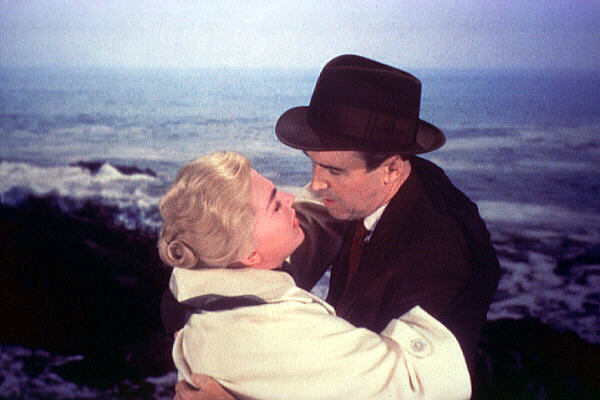
If you're like me and get glassy-eyed at the thought of vegetables, if you basically hate the whole idea
of salad, yet still think it would be a good idea to eat these things
from time to time, the key to everything is sauces and dressings.
The strategy is to come up with a sauce or dressing so good that the
concept of vegetables and greens as food is eliminated — they become simply the means of conveying some sort of tasty topping into the mouth.
For salads, you can't just buy some Paul Newman's gourmet dressing and
think that will do the trick. This stuff tastes like salad
dressing — salad
dressing. It's there to “dress”, to tart up, something you don't
want to deal with in the first place. You need to be
creative. You need to make something yourself which doesn't
resemble anything you've ever encountered at the dressing station of a
salad bar.
Here's a recipe from Rick Bayless, that guy on PBS who does shows about
Mexican cooking, for creamy queso añejo dressing. Queso añejo is
a flavorful aged Mexican cheese which tastes a bit like Romano.
You can find it at just about any Mexican market (look for the kind
that's actually made in Mexico) but Romano, which you can find
anywhere, works just as well.
Start with 3/4 of a cup of olive oil in a mixing bowl or blender.
Add 1/4 of a cup of rice vinegar. Add 3 tablespoons of
mayonnaise. Add 3 generous tablespoons of grated (freshly grated!)
queso añejo or Romano. Add slightly less than a tablespoon of
salt. Add 2 to 4 cloves of roasted garlic.
Attention!
Here's the simple way to roast garlic. Put the unpeeled cloves in
a dry skillet over medium heat. Roast the cloves, turning them
often, until they're soft and splotchy brown. It takes about 15
minutes. Remove them from the skillet and when they're cool
enough to handle, remove the skins. Put the 2 to 4 cloves into
the mixing bowl or blender — if you're
going to be mixing the dressing by hand, run the garlic through a garlic press before you add
it to the bowl. (Be sure to roast a good number of
extra garlic cloves to eat while they're still warm — few things are more
delicious . . . mild, nutty and slightly sweet.)
Add some chopped-up cilantro or parsley if you feel like it.
Mechanically blend or mix (with a whisk) the contents of the
bowl. Add a little more salt to the dressing if needed then
pour it over Romaine or butter lettuce for a most delightful
dish. Save what's
left in a sealed glass jar in the refrigerator — but trust me, it
won't last long. It's just too good. You'll wonder why you
didn't buy more lettuce.